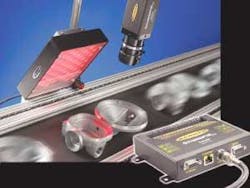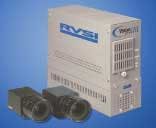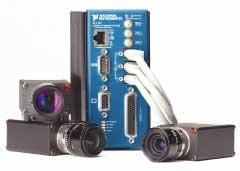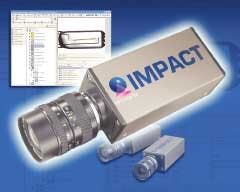Machine-vision systems offer design alternatives
Bridging the gap between smart cameras and custom designs, integrated systems provide a fast way to automate industrial processes.
By Andrew Wilson, Editor
In the development of industrial-automation applications, a number of specific hardware choices must be made. Machine-vision applications such as web inspection demand high-speed linescan cameras, dedicated frame grabbers, and custom OEM software. In such applications, developers can choose from several off-the-shelf components to build their systems. In less-demanding applications, where images may not need to be rapidly captured and analyzed, programmable smart cameras with standard bus interfaces such as FireWire and Gigabit Ethernet may perform specific tasks at a lower cost.
In many cases, however, the time needed to develop integrated machine-vision systems that incorporate lighting control, data acquisition, and PLC interfaces is a major factor. Because of this, vendors currently offer integrated systems that can provide much of the functionality of custom-built PC-based systems developed using off-the-shelf boards. By offering integrated environments, these systems reduce the integration effort and speed the time to market for industrial automation applications.
WITHOUT PC
The PresencePLUS Pro from Banner Engineering, for example, features Ethernet, serial, and flexible I/O in a single unit (see Fig. 1). After programming the unit with a PC, inspection data are stored in the system and can be run without the need for the PC. Information for system process control is communicated over Ethernet or serial protocols. The unit's pluggable terminal block accommodates configurable inputs (NPN/PNP) and outputs (NPN/PNP) and allows stored inspections to be selected.
Like Banner's product, the Cognex In-Sight 3400 also can be operated without a host PC. Compatible with the company's In-Sight Explorer integrated user environment, In-Sight 3400 comprises a vision processing unit and a digital camera. The In-Sight 3400 also features discrete I/O, a standard VGA output for real-time display, and a 10/100 Base-T Ethernet port.
Of course, certain trade-offs must be made when specifying such systems. These include the types of camera interfaces, processing power, software support, and I/O capabilities. Many system vendors offer camera interfaces with their products, including standards such as Camera Link, FireWire, and analog inputs, which enable a number of different camera types to be supported.
To process captured images, PC-based systems often use standard Pentium processors, allowing vendors to leverage the power of established Windows-based development tools. These systems are generally tailored to operate in networked factory-floor environments, where it is often necessary for the system to control external peripherals such as lighting and to be networked to other data-acquisition devices over Ethernet. Consequently, Ethernet, digital, and analog interfaces are often provided as standard.
Visionscape Express from RVSI, for example, is a stand-alone machine-vision system that offers more than 50 vision tools and can be configured with several vision accelerators for a variety of analog and digital camera interfaces (see Fig. 2). Each system is configured with 10 optoisolated digital I/O points that are wired directly to terminals on the back of the system. For expanded capabilities, an optional external optoisolated I/O board provides 24 digital I/O points and eight analog outputs.
BORN FROM BOARDS
Many systems vendors have emerged from companies that initially offered board-level frame grabbers and image processors. Others have evolved from companies that initially offered smart cameras or machine-vision sensors. As a result, two classes of company now exist in the OEM machine-vision industry.
Interestingly, most of the North American OEM systems are offered by companies that originally developed board-level products. Many of the systems developed by Japanese vendors come from companies that originally targeted industrial automation with low-cost proximity switches and smart cameras. To broaden their product lines, all these manufacturers now offer smart cameras, board-level products, and machine-vision systems. But the software offerings fall into two distinct classes.
For a number of years board manufacturers have offered frame grabbers and image processors with sophisticated software-development kits (SDKs) that they have gradually developed, adding features such as optical character recognition (OCR), geometric pattern-matching, and color analysis as market requirements dictated. These vendors have successfully ported their software to their systems, giving an easy way to upgrade or integrate existing code into a stand-alone system. By providing easy-to-use point-and-click interfaces with a broad collection of high-level vision tools, systems integrators can rapidly develop inspection, dimensional gauging, guidance, and image-identification applications.
Perhaps best known for its LabView integrated software-development package, National Instruments (NI) offers a number of boards for data acquisition, machine vision, and motion control. The company introduced its first machine-vision systems last year, the CVS-1450 Compact Vision series, which leverage the power of the LabView environment (see Vision Systems Design, July 2003, p. 45).
Sporting three FireWire ports and a range of digital I/O options allows the CVS-1450 to communicate with PLCs, relays, and robotics systems (see Fig. 3). NI offers Vision Builder for Automated Inspection to support the system. The configurable machine vision software does not require programming yet is scalable to environments such as LabView. A built-in deployment interface is included to set up pass/fail decisions to control digital I/O devices and to communicate with serial devices such as PLCs.
EASY INTERFACES
Like their North American counterparts, overseas companies have recognized the need to supply easy-to-use interfaces with their products and to provide a range of machine-vision capabilities. Because these companies develop complete image-processing "solutions," however, the hardware/software combination supplied can, in some cases, be regarded as a point-product solution, since many overseas manufacturers do not offer board-level products.
System specifications also can be a little daunting, because some suppliers have products with proprietary camera interfaces, and developers are left to question whether factors such as camera resolution and data-transfer rate will meet their application. These systems are marketed as "complete solutions," and manufacturers state that this knowledge is not required; systems developers must often evaluate systems on software specifications alone.
Despite this, the emergence of machine-vision systems does much in reducing the systems-integration burden and speeding time to market of industrial-automation systems. In addition, vendors have realized the increasing capability of today's smart cameras. Offering on-board image capture, processing, I/O control, and networking capability, these devices are being used increasingly in applications that may not demand the power of a complete stand-alone image-processing system.
null
Both Matrox and PPT Vision have recently introduced smart cameras that leverage their existing software (see Fig. 4). At this year's IPOT Show in Birmingham, UK, Matrox announced its first smart camera, the Iris P Series. An embedded Intel processor runs a Windows CE .NET real-time operating system and can be programmed using Microsoft development tools and the Matrox Imaging Library. Fitted with a monochrome or color CCD sensor, the camera features an externally triggered or internally controlled electronic shutter, Ethernet interface, and auxiliary digital I/Os.
At the recent Vision Show East (Boston, MA, USA), PPT Vision introduced the Impact T10 Intelligent Camera, designed to use the company's Inspection Builder software to provide customers with a camera-based vision system. PPT has now established two Impact machine-vision product lines: the existing, higher-performance C-series, in which the processor is separate from the camera, and the lower-priced, fully self-contained T-series intelligent camera.
INCREASED CHOICE
While several Japanese vendors also offer smart cameras as part of their product portfolios, it is only recently that US vendors known for board-level and system-based products have entered this market. By introducing smart cameras, these companies have once again leveraged their established software allowing the systems developer to implement similar software on different platforms. This provides the systems integrator with a choice of board-level products, smart cameras, and systems and allows different system configurations to be built while maintaining software compatibility across various devices.
This is a welcome move from the past, when systems integrators were left with numerous options and software choices. Despite these advances, however, choosing a machine-vision system continues to be based to a large extent on each integrator's legacy experience. Those who are familiar with a specific software package will likely not be convinced to change based on a single manufacturer's hardware or software.
Still, the move by such companies to broaden their product lines with cameras, frame grabbers, and machine-vision systems is positive. And in the future this trend may continue, but it may not be driven by companies developing hardware. While hardware manufacturers diversify their product ranges, machine-vision software suppliers will look to port their products onto smart cameras, PCs, and stand-alone image-processing systems. By doing so, the systems integrator will be left with a wider range of—albeit company-specific—software-compatible peripherals to choose from when specifying a machine-vision system.
Click here to download Integrated machine-vision systems speed systems integration as .pdf {pdf size = 171KB}.





